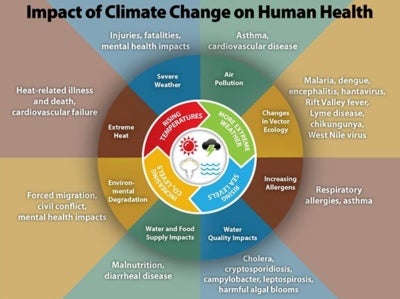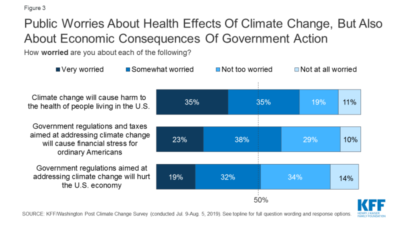Climate change is not always easy to perceive. It may seem distant, far away, or less urgent than many of the other challenges we face. Especially today, as we face a global pandemic, it may not appear to be an immediate threat like COVID-19. However, the warming planet has impacts that are pervasive, immediate, and endanger our health and safety, and we cannot afford to wait any longer to act. If you care about your health, you should care about climate change, too.
Climate change can lead to adverse health outcomes in both direct and indirect ways. Severe storms and heatwaves are sudden and can be deadly. Longer-term impacts such as increased heart disease, respiratory complications from worsened air quality, increased incidence of vector-borne disease, and reduced access to clean water and healthy food are more difficult to understand. The true breadth of the impact of climate change on health cannot be reduced to one single number.
The Centers for Disease Control and Prevention (CDC) lists air pollution, allergens, diseases carried by vectors, food and waterborne diarrheal disease, food security, mental health and stress-related disorders, floods, temperature extremes, and wildfires for “climate-related effects on health.” These are only the beginning. Climate change is already a health emergency and will expand in the years to come.
Not only do weather events that result in flooding have immediate and devastating impacts on communities, but there are also concerning long term health impacts. For example, infrastructure damaged during hurricanes can become susceptible to water intrusion, which may lead to increased rates of asthma, other upper respiratory symptoms, and lower respiratory infections, such as pneumonia.
Higher global temperatures will lead to increased ozone concentrations at ground level and higher levels of harmful particulate matter in the air, which, according to the CDC, could lead to the premature deaths of 1,000 to 4,300 Americans per year by 2050.
According to the MGH Institute of Health Professionals, warming of 2-3 degrees Celsius is estimated to increase the number of people at risk of malaria by up to 5 percent (more than 150 million people globally). There is also a close link between climate change and dengue whose transmissibility has increased by 3 to 5 percent since 1990.
Even more fundamentally, incidents of water and food insecurity will continue to increase as crops become increasingly diseased and water sources contaminated. For every 1-degree Celsius rise in global temperature, a 6 percent decline in global wheat yields and a 10 percent decline in rice yields is expected. In the United States in 2018, just over 11 percent of households were already food insecure at some point during the year. In the world, more than 820 million people already go hungry.
The global community’s inability to mobilize quickly to prevent the spread of COVID-19 illustrates the hurdles we will need to overcome when dealing with global emergencies of scale in the future, including those that are more difficult to perceive and evolve over longer time horizons. However, the coronavirus crisis has also illustrated that health is a motivating factor for action and that there are things we can do as a society to mitigate and adapt. In fact, if we are driven, we have an immense ability to change together.
According to a survey about climate change conducted by the Kaiser Family Foundation and the Washington Post, seven in ten US adults are worried that climate change will cause harm to the health of people living in the U.S. and a majority think that businesses, the government, energy companies, and state governments are doing too little. Although it seems like awareness is starting to grow, the policy and behavioral changes needed have not yet been enacted. This data should be used by policymakers as they work toward finding solutions. The desire for change is beginning to break through and is sure to grow as the impacts become more pronounced. Let’s not wait for a breaking point.
Like many other challenges, climate change and public health must be addressed through an environmental justice and health equity lens. The environmental and health consequences of climate change have the greatest impact on those who are most vulnerable including the poor and low-income earners, members of minority groups, children and the elderly, those with chronic diseases, underlying health conditions, and disabilities, among others. (And though it goes beyond the scope of this piece, it’s important to note that on a global level, low-income countries who are producing the lowest levels of greenhouse gases are also the countries who experience the impacts more intensely, and are less able to cope.)
Strategies to address climate change’s impacts on health must prioritize vulnerable populations and make up for historic inequity while producing co-benefits for all populations in the United States. Given the interconnected nature of our world, solutions to climate change and public health are not just about increasing access to health care and reducing greenhouse gas emissions (though those are critical), it’s also about ensuring access to safe and affordable housing and paid sick leave for hourly wage workers, among others. Access to protections for everyone will protect us all.
As is the case with every challenge that faces humanity—both on local and global scales—we are presented with an opportunity to work together to design better solutions. The work of the Aspen Institute’s Energy and Environment Program is defined by three core pillars: Adaptation, Mitigation, and Building Relationships for Cooperation. As the program continues to expand in its topical scope, addressing the intersection of climate change and public health is of great importance. Partnerships between public and private sectors, governments and community organizers, health officials, doctors, and scientists already exist; the Energy and Environment Program’s goal is to ensure that those partnerships continue to strengthen while addressing some of the key questions in the space.




